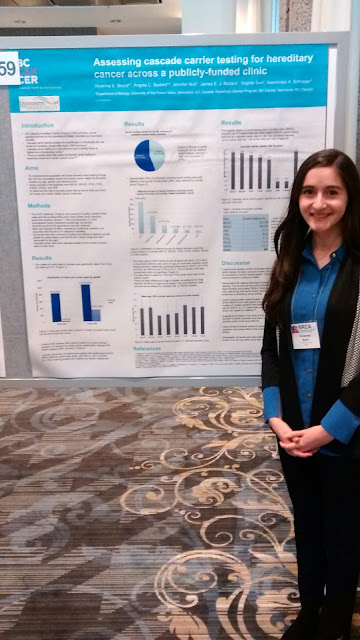Today we dove head first into all things HBOC! The majority of the day was spent hearing lectures from genetics experts and presentations of proffered papers. The day was divided into four sessions, covering everything from classification of BRCA variants, molecular genetics of HBOC, DNA repair in the clinic, and global perspectives on HBOC. During lunchtime I attended a session sponsored by HeritX, an organisation with the aim of developing and promoting non-surgical treatments for HBOC.
 |
| For some reason, I manage to always match my posters. I didn't plan it, I promise! I had two nurses from Hong Kong stop by, a geneticist from Denmark and two from Switzerland, an oncologist from the US, and a few genetic counselors from Canadian provinces and US states. We had some thought-provoking discussions, and it was amazing to link what we have been doing in BC with what other clinics around the world are up to. For example, the two geneticists from Switzerland were very excited to see a poster on cascade carrier testing, as they are currently working on a carrier testing study in their clinic back home. They asked me about carrier testing in the HCP for Lynch Syndrome (a hereditary cancer syndrome associated with increased colorectal and endometrial cancer risks) and I excitedly told them that colorectal cancer syndromes were actually the primary focus of my research project this past year (not on this poster, however). Also, the poster directly in front of mine was presented by a lovely lady from Memorial University in Newfoundland who focused on individuals' perceptions of group counselling sessions for HBOC. Her results looked promising that more group counselling could potentially help to decrease long wait times and help reach more at-risk individuals. |
 |
Here is a peek of the session 1 outline and my handy notebook! Session 1 was all about classifying variants of BRCA1/2. One of the challenges with genetic testing for hereditary cancer is the identification of "variants of uncertain significance" (also called a VUS). This means that testing found a change (variant), but whether that variant is pathogenic or benign is not yet known. There were talks by researchers from Ambry genetics, Myriad genetics, and Invitae. Dr. Rachid Karam of Ambry genetics gave a very interesting talk on the use of RNA studies and functional assays to improve variant classification (i.e. benign or pathogenic). A point that stood out to me was that the use of RNA studies enabled Ambry to improve the classification of splice site variants so that 92% of variants that used to be called VUS is now only 8%!
During session 2, Dr. Marjanka Schmidt of the Netherlands Cancer Institute gave a wonderful lecture on the pathology and outcome for carriers of pathogenic variants in BRCA1, BRCA2, and other genes associated with increased breast and ovarian cancer risk (ATM, PALB2, CHEK2). For example, she explained how ATM tumors tend to be estrogen receptor (ER) positive (meaning that the cells can still respond to estrogen) and do not necessarily occur at a younger age. In contrast, PALB2 tumors tend to be ER negative or triple negative, but also may not be early onset. |
 |
| Session 3 held one of my favourite talks of the day. Dr. Alan D'Andrea presented on an organoid analysis of 12 patients with high grade serous carcinoma (HGSC) of the ovaries. Dr. D'Andrea explained that 50% of HGSC ovarian cancers have mutations in DNA repair genes. What is so fascinating about organoids is that they can be grown in the lab from a patient's original tumor cells in just 3 to 10 days! Physicians can then do functional tests on these organoids, thereby enabling more personalized, patient specific treatment. There were many additional interesting talks in this session, such as presentations on replication fork instability and opportunities for treatment, as well as the link between BRCA2 and prostate cancer. |
 |
| Last but not least, the fourth session of the day focused on global perspectives on HBOC. This was very eye-opening, as different countries have varying resources, treatment recommendations, and diverse needs. In Africa, for example, there is a huge lack of genetic counselors. Additionally, in both Africa and Asia, there are sociocultural factors that may serve as barriers to testing, such as the view of an inherited mutation as an inherited "flaw" that brings shame. Dr. Mercy Laurino gave a captivating talk on work being done in Asia (with a focus on the Philippines) and discussed the needs of these populations. Dr. Dominique Stoppa-Lyonnet gave a very interesting description of recommendations in France. Interestingly, patients who test positive in France have a legal obligation to inform relatives of their result. Did you know that there are 147 cancer clinics in France alone?! Finally, Dr. Maria Achatz presented on the needs of Brazil. Like in Africa, there is a need for more genetic counselors in Brazil. What makes it more challenging is that, unlike in BC, genetic counselors in Brazil are not allowed to have phone appointments. There are definitely pros and cons to this rule, but it does mean that patients have to wait longer to see one of the few counselors. One of the most interesting parts of Dr. Achatz's talk was her description of how a founder TP53 mutation in Brazil was traced back to a travelling "trouper" who, many, many years ago traveled from town to town "spreading his genes." I find it amazing that they were able to go so far back and discover this. |
 |
And to end this post, feast your eyes on a very fancy-looking dessert during the lunchtime session! Today was a packed day and I learned so much. Looking forward to hearing a plethora of additional talks tomorrow, as well as browsing through research posters!
Until then,
~ Vivienne |








Comments
Post a Comment